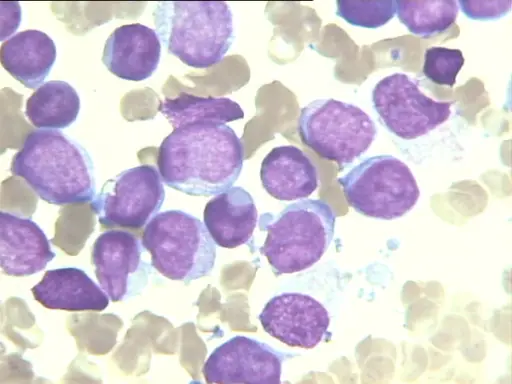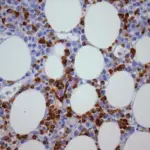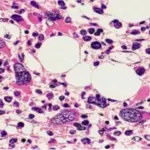Acute myeloid leukemia is a tumor of hematopoietic progenitors caused by acquired oncogenic mutations that impede differentiation, leading to the accumulation of immature myeloid blasts in the marrow.
What is the Pathology of Acute Myeloid Leukemia?
The pathology of acute myeloid leukemia is:
-Etiology: The cause of acute myeloid leukemia is related to the replacement of the mature bone marrow cells with blasts which produces marrow failure leading to complications such as anemia, thrombocytopenia and neutropenia.
-Genes involved: TP53 or p53.
-Pathogenesis: The sequence of events that lead to acute myeloid leukemia involve four functional categories:
(1) Transcription factor mutations that interfere with normal myeloid differentiation
(2) Mutation of signaling proteins that result in constitutive activation of pro-growth survival pathways
(3) Mutations of genes that regulate or maintain the epigenome
(4) Mutations of TP53 or genes that regulate p53
-Histology: The histology associated with acute myeloid leukemia shows the presence of at least 20% myeloid blasts in the bone marrow. It may be present as myeloblasts or monoblasts. Myeloblasts have delicate nuclear chromatin, two to four nucleoli and more voluminous cytoplasm than lymphoblasts. The cytoplasm contain needle shaped, peroxidase-positive azurophilic granules called Auer rods. Monoblasts have folded or lobulated nuclei, lack Auer rods and are nonspecific esterase-positive.
How does Acute Myeloid Leukemia Present?
Acute myeloid leukemia may occur at any age but the incidence rises throughout life peaking after 60 years of age. The symptoms, features, and clinical findings associated with acute myeloid leukemia include complaints related to anemia, neutropenia and thrombocytopenia, most notably fatigue, fever and spontaneous mucosal and cutaneous bleeding. Cutaneous petechiae and ecchymoses, serosal hemorrhages into the linings of the body cavities and viscera and mucosal hemorrhages into the gingiva and urinary tract are common. Acute myeloid leukemia occasionally presents as a localized soft tissue mass called a myeloblastoma.
How is Acute Myeloid Leukemia Diagnosed?
Acute myeloid leukemia is diagnosed by physical examination done by a health care provider checking for signs of bruising, bleeding or infection, enlarged liver, spleen or lymph nodes. Blood tests (complete blood count and peripheral smear) and bone marrow biopsy are also used to diagnose acute myeloid leukemia.
How is Acute Myeloid Leukemia Treated?
Acute myeloid leukemia is treated with chemotherapy, monoclonal antibody therapy and stem cell or bone marrow transplant.
What is the Prognosis of Acute Myeloid Leukemia?
The prognosis of acute myeloid leukemia is poor.




